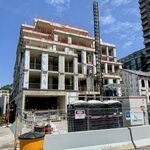From The Star, Feb 9, 2008
Transit review changes knocked
Activists say concerns may be ignored under new time constraints
Feb 09, 2008 04:30 AM
Paul Moloney
city hall bureau
Ontario's new speedy environmental assessments will prevent people from rallying against ill-advised transit projects being rammed through their neighbourhoods, community activists say.
While seen as a stalling device for not in my backyard (NIMBY) opponents, environmental assessments have afforded residents the time to research and point out flaws in proposed projects, they say.
In the case of the long-delayed high-speed rail link from downtown to the airport, residents of Weston were able to propose a better solution, said Mike Sullivan, spokesperson for the Weston Community Coalition.
"What the community has said is, `Look, let's build transit that can be used by the people,'" Sullivan said. "Make it a subway link. Give it 10 or 12 stops along the way, and it would still get to the airport really fast."
Sullivan said he objects to the NIMBY label.
"We're actually YIMBYs, yes in my backyard, but make it good transit. Do that, and you wouldn't get an objection from anybody."
A longtime critic of the city's dedicated streetcar line along St. Clair Ave. W., said a six-month limit for environmental assessments would allow the city and the Toronto Transit Commission to slough off local concerns.
Margaret Smith said environmental assessments force the authorities to listen.
"The truth really is they go through the motions," Smith said. "They really don't want to hear anything from the public except comments like, `You're doing a great job. Keep it up.'"
But the provincial government's move to impose a six-month limit on environmental assessments was hailed by Mayor David Miller, who said he recently discussed the issue with Environment Minister John Gerretsen.
"He understands when you're building transit, by definition, it's good for the environment," Miller told reporters yesterday. "The process has gotten out of control. It's preventing transit being built."
Miller is pushing for his ambitious multi-billion-dollar Transit City plan that would see dedicated streetcar lines running in their own rights of way along major streets.
"We want to get going," he said. "It's good for the people of Toronto. If people want to get around this city, we need to build rapid transit and we need to do it in a realistic time."
A six-month time limit means the focus will stay on the environment and not stray to include other concerns about a given transit project, said TTC chief general manager Gary Webster.
"It doesn't take away the public consultation, but it's a little more structured and focuses on the important issues and hopefully allows us to proceed," Webster said.
"The new process doesn't necessarily mean there's not going to be any battles," he added. "It just allows us to deal with the issues in a focused way in a shorter period of time."
Webster said he expects the Transit City lines will score well environmentally.
"People will use it, ridership goes up, there's all kinds of environmental benefits," he said, adding the TTC hopes to begin work on two lines, along Finch and Sheppard, early next year.
"In 2008, we're going out to the various communities to tell them that we're coming," he said.




